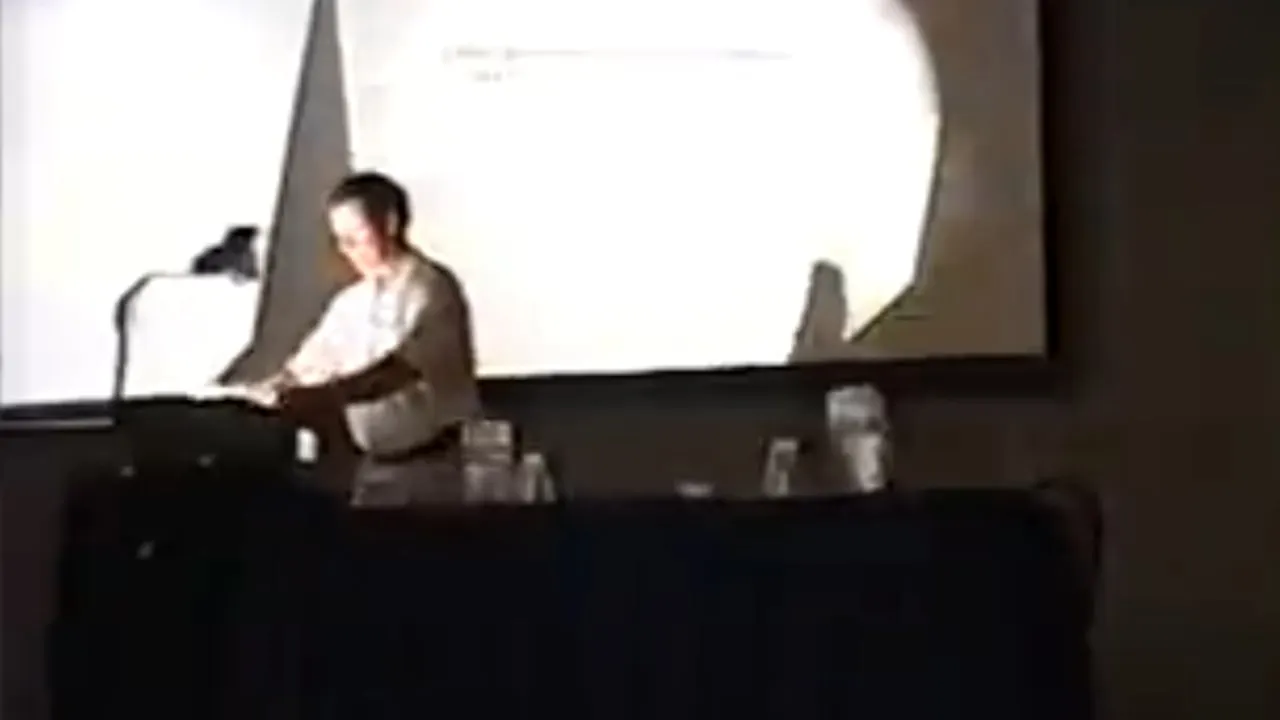📽️ NEW: Bitcoin legend Hal Finney discusses Zero-Knowledge Proofs in a newly unearthed presentation, made 25 years ago at Crypto '98 in Santa Barbara.
Have you ever heard @halfin's voice before? 🤯 pic.twitter.com/HdddworTsg
— Trust Machines (@trustmachinesco) September 20, 2023
Coin Prices
BTC
$87,396.00
-1.60%ETH
$2,927.58
-1.31%BNB
$834.75
-0.57%XRP
$1.85
-0.93%USDC
$0.999893
0.01%SOL
$122.96
0.23%TRX
$0.27929
-0.10%STETH
$2,926.29
-1.32%DOGE
$0.122714
-2.05%FIGR_HELOC
$1.026
-1.19%ADA
$0.352388
-0.15%WBT
$56.14
-1.58%BCH
$601.84
-0.65%WSTETH
$3,578.79
-1.31%WBTC
$87,274.00
-1.57%WBETH
$3,181.38
-1.36%USDS
$0.999785
0.02%WEETH
$3,173.77
-1.35%BSC-USD
$0.999145
0.01%LINK
$12.19
-1.62%XMR
$444.85
0.01%LEO
$8.43
-0.27%ZEC
$467.06
5.80%WETH
$2,926.77
-1.33%XLM
$0.213318
0.06%CBBTC
$87,387.00
-1.67%USDE
$0.998447
0.02%HYPE
$25.84
3.66%LTC
$77.19
-0.47%AVAX
$12.40
-0.69%SUI
$1.40
0.09%HBAR
$0.112074
0.15%SUSDS
$1.078
-0.71%USDT0
$0.99922
0.02%SHIB
$0.00000717
-0.26%WLFI
$0.142192
0.85%TON
$1.55
1.68%UNI
$5.96
0.47%PYUSD
$0.999678
0.07%CC
$0.099605
-2.71%CRO
$0.092422
-0.91%SUSDE
$1.21
0.05%MNT
$1.047
0.26%USD1
$1.00
0.01%DOT
$1.75
0.59%RAIN
$0.00770876
9.78%M
$1.42
6.17%BGB
$3.45
-0.28%XAUT
$4,532.31
0.27%AAVE
$155.40
1.91%OKB
$107.24
-0.85%USDF
$0.997966
0.04%TAO
$215.96
-3.01%NEAR
$1.53
-0.80%ETC
$11.68
-1.52%WETH
$2,928.57
-1.25%JITOSOL
$153.80
0.26%BUIDL
$1.00
0.00%PI
$0.204399
-0.33%ASTER
$0.717234
3.82%PEPE
$0.00000402
0.55%ICP
$3.02
-0.34%PAXG
$4,551.02
0.66%ENA
$0.21085
0.84%HASH
$0.03046249
-6.99%USDG
$0.999555
-0.00%SOL
$122.96
0.13%USYC
$1.11
0.00%HTX
$0.00000164
0.14%JLP
$4.48
-0.40%SYRUPUSDC
$1.14
0.02%SKY
$0.062755
-7.73%KCS
$10.79
-0.39%RLUSD
$0.999721
-0.01%NIGHT
$0.081433
4.94%BFUSD
$0.999199
0.02%WLD
$0.493372
-0.94%USDC
$0.99968
0.00%APT
$1.70
0.30%BNSOL
$134.22
0.34%RETH
$3,375.10
-1.36%GT
$10.24
0.31%KAS
$0.04468733
-2.30%ONDO
$0.373677
-2.00%WBNB
$834.73
-0.56%ARB
$0.193304
0.85%POL
$0.104326
-0.68%RSETH
$3,107.31
-1.27%PUMP
$0.00183005
4.18%QNT
$71.66
-2.70%ALGO
$0.117346
-1.01%JAAA
$1.019
0.00%TRUMP
$4.95
0.10%ATOM
$2.03
-0.64%FBTC
$87,226.00
-1.30%SOLVBTC
$87,273.00
-1.68%LBTC
$87,282.00
-1.90%XDC
$0.050329
3.87%VET
$0.01060939
-0.52%NEXO
$0.907458
-1.18%FLR
$0.0112366
-1.27%FIL
$1.24
-0.27%USDTB
$0.999157
0.05%LSETH
$3,127.98
-1.50%OUSG
$113.77
0.02%USDD
$0.99935
0.02%USTB
$10.94
0.01%WM
$0.999828
0.02%BDX
$0.098316
-0.78%USDC.E
$0.999722
0.01%SEI
$0.110988
0.44%WBTC
$87,188.00
-1.57%USDY
$1.11
0.87%CLBTC
$88,809.00
0.27%METH
$3,171.11
-1.14%MYX
$3.48
4.17%RENDER
$1.27
-0.22%BONK
$0.0000079
-0.41%EZETH
$3,120.39
-1.34%USDAI
$0.999935
0.05%KHYPE
$26.06
3.75%WFLR
$0.01123204
-1.29%MORPHO
$1.17
-0.81%DAI
$0.999541
-0.04%JUP
$0.200377
0.22%WETH
$2,927.19
-1.31%CAKE
$1.81
-0.71%OSETH
$3,087.13
-1.35%JUPSOL
$142.47
0.23%PENGU
$0.00904718
-0.86%SYRUPUSDT
$1.11
0.04%CRV
$0.381306
-3.71%EUTBL
$1.23
-0.07%USD0
$0.996716
0.10%TBTC
$87,249.00
-1.22%CTM
$0.120606
-0.59%OP
$0.270398
2.04%WETH
$2,926.78
-1.34%FDUSD
$0.997807
-0.06%IP
$1.50
1.01%XTZ
$0.471927
5.13%DASH
$40.05
3.06%FTN
$1.14
8.54%GHO
$0.999088
-0.05%TUSD
$0.998361
0.04%FET
$0.213293
2.75%PIPPIN
$0.487443
-4.89%LDO
$0.56659
1.58%STX
$0.257177
1.58%GTETH
$2,926.54
-1.34%MERL
$0.426758
-4.07%INJ
$4.63
-0.61%ETHFI
$0.706673
3.56%VIRTUAL
$0.700383
-0.07%SPX
$0.49134
2.13%ETHX
$3,152.14
-1.36%AERO
$0.473637
-2.78%AB
$0.00458233
-1.50%LIQUIDETH
$3,138.78
-1.32%MSOL
$165.75
0.24%WAPE
$0.204874
1.23%USDB
$1.002
1.11%STRK
$0.080656
-0.05%SBTC
$89,311.00
0.83%2Z
$0.113962
-7.67%TEL
$0.00415472
4.58%TIA
$0.459785
-0.41%GRT
$0.03668503
1.13%SYRUP
$0.33961
-0.15%SWETH
$3,216.41
-1.45%FLOKI
$0.00004006
-0.82%BTT
$0.00000039
-1.27%STEAKUSDC
$1.11
-0.05%JST
$0.03802037
0.83%CBETH
$3,273.24
-1.34%CFX
$0.072462
-0.36%CHZ
$0.03636825
6.38%BSV
$18.12
-1.45%SUN
$0.01883674
0.01%ENS
$9.45
-0.92%IOTA
$0.08458
-0.32%EURC
$1.18
-0.19%OHM
$21.39
-0.79%TWT
$0.839302
3.78%KAU
$145.89
0.29%CUSD
$0.999749
-0.01%NFT
$0.00000035
-0.04%PYTH
$0.059739
-0.66%BTC.B
$87,400.00
-1.58%USR
$0.99979
0.05%CRVUSD
$0.997948
-0.03%WSTUSR
$1.13
0.04%KAIA
$0.055933
-1.95%GNO
$123.44
-0.19%DCR
$18.84
14.23%BAT
$0.215445
0.88%DOGE
$0.122729
-2.06%WIF
$0.314565
-0.56%BUSD
$0.998882
-0.04%EETH
$2,927.02
-1.35%USX
$0.999339
2.06%SAVAX
$15.36
-0.66%PENDLE
$1.86
2.45%FARTCOIN
$0.303846
0.79%XPL
$0.14505
7.26%WEETH
$3,171.16
-1.25%JASMY
$0.00596935
-1.92%KAG
$79.21
5.55%SAND
$0.112428
-1.33%UBTC
$87,378.00
-1.61%GALA
$0.00606864
-2.02%FLOW
$0.173342
-0.22%H
$0.15432
-2.89%FRXETH
$2,910.04
-1.35%FRAX
$0.991677
0.01%CMETH
$3,170.46
-1.01%S
$0.072647
-0.98%HNT
$1.47
-1.98%VSN
$0.076831
-9.29%WETH
$2,926.34
-1.34%BEAT
$1.91
0.29%FDIT
$1.00
0.00%QRL
$3.36
6.83%JTRSY
$1.09
0.02%GTBTC
$87,551.00
-1.60%MON
$0.02413908
3.21%THETA
$0.259749
-2.93%WHYPE
$25.83
3.66%BORG
$0.263623
-1.88%COMP
$26.66
0.42%ASBNB
$884.33
-0.63%ZBCN
$0.00261586
-2.59%ZK
$0.0295841
0.84%A
$0.156911
0.27%MWC
$23.38
4.93%WSTX
$0.252366
1.69%BBTC
$86,991.00
-1.57%ZRO
$1.24
-0.29%NEO
$3.55
-0.85%RAY
$0.912028
0.34%WETH
$2,925.67
-1.36%BTSE
$1.48
-1.73%SUSDAI
$1.06
0.11%UDS
$2.32
-1.46%APEPE
$0.00000112
0.16%WSTETH
$3,578.46
-1.30%USDC.N
$0.999041
-0.12%WAETHUSDC
$1.16
0.01%


